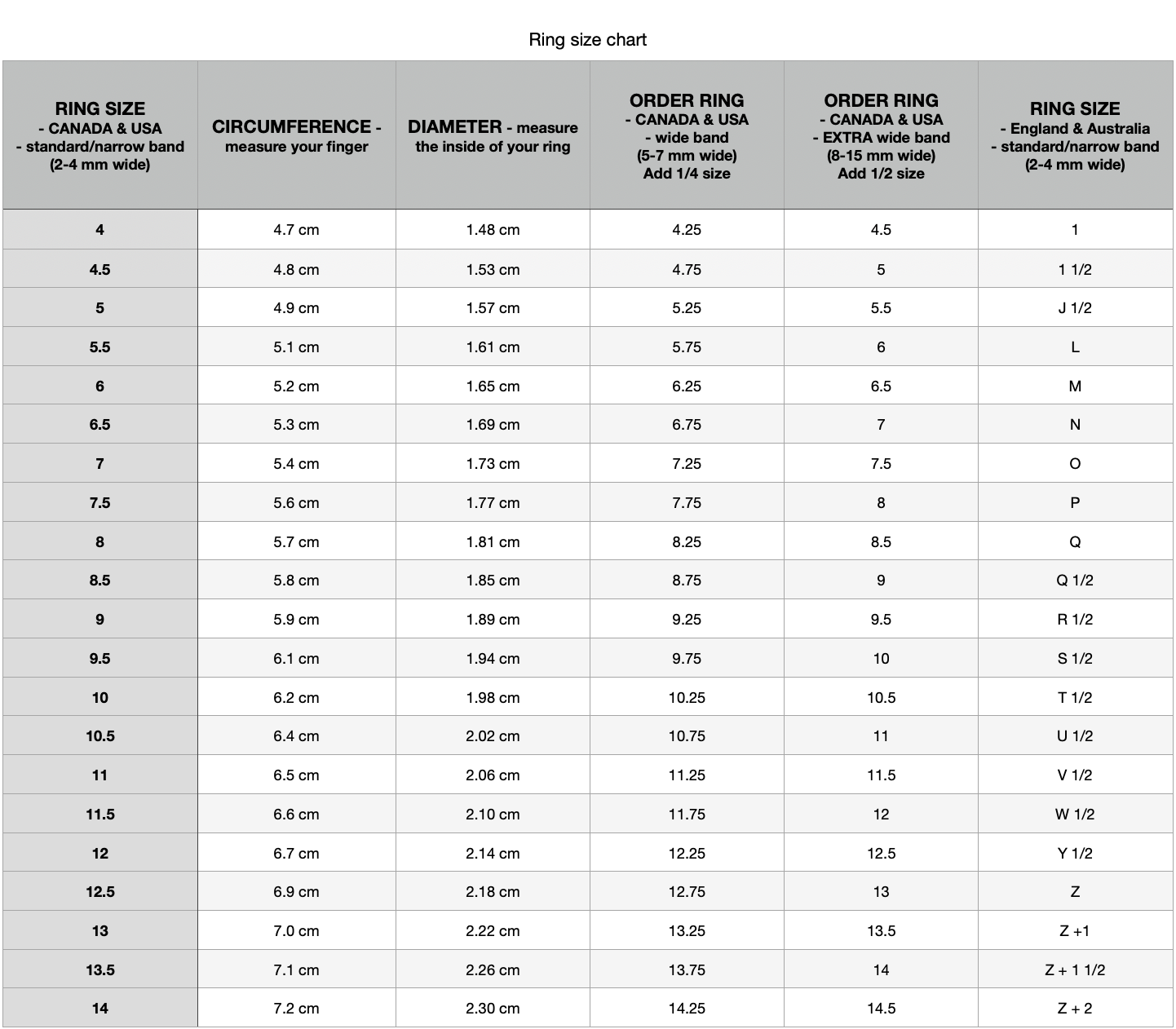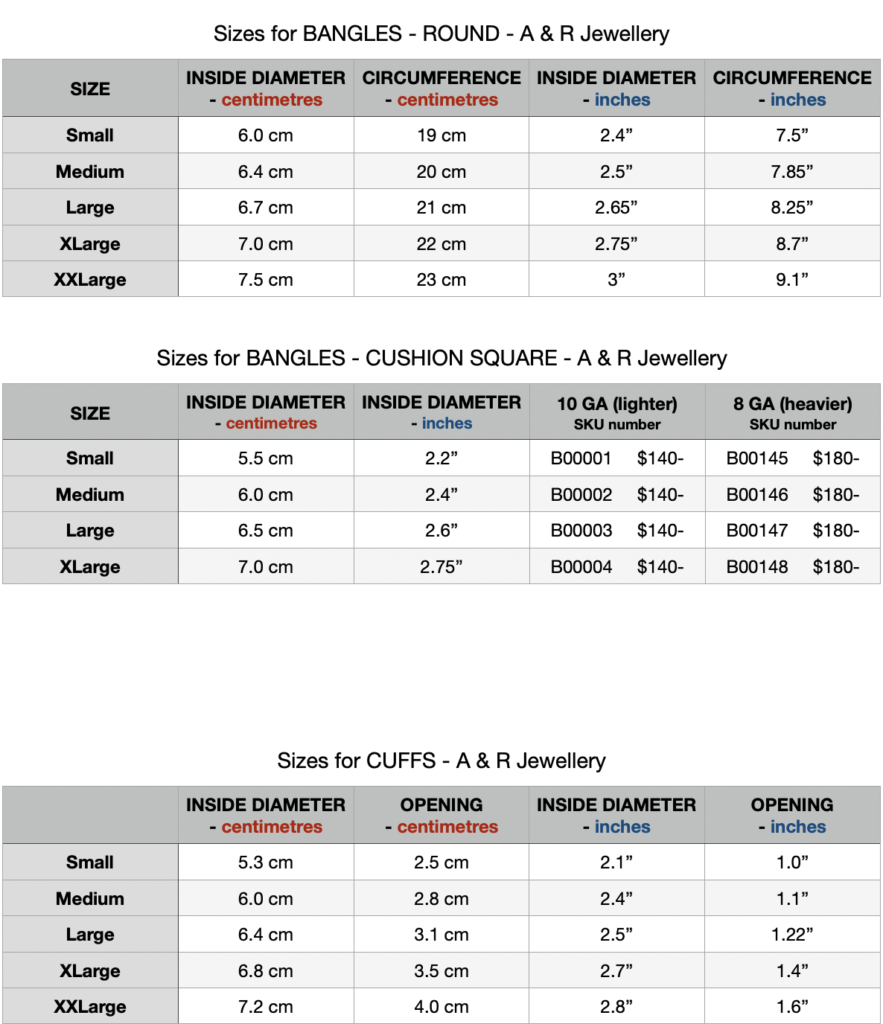Ring and bracelet sizing information
Ring Sizing Guide
Rules to size by:
Rule #1: Rings should fit firm, not too tight, not too loose. Rings should go on with some resistance and by
resistance, we do not mean a struggle. Likewise, rings should come off with some resistance, but not a struggle.
If you do end up struggling to get your ring off, use Windex – We’ve tried it all and miraculously, it works the best.
Men tend to get themselves a ring that fits on the looser side. This explains how so many wedding bands have
gotten lost (Ryan is on his third). We urge you, gentlemen, to choose a snugger fit next time, so you can keep those rings on your fingers.
Rule #2: Trust your fit preference. Some like their rings extra snug, maybe their rings get stuck sometimes but
they deal with it. Some like their rings loose enough that it spins around their finger comfortably. It’s OK to ask
yourself what you like best and then stick with this fit.
Rule #3: Choose the larger size if you feel you’re between two sizes. Only go smaller if you’re sure you love a
snug fit.
How to size for different ring types:
Double bands and rings with holes are designs that let your finger breathe. They won’t make your finger sweat and swell as much since there’s more wiggle room. For rings with breathing room, it’s alright to choose a smaller
size.
Square bands also will let your finger breathe because the open corners won’t be so tight to your skin. Feel free
to choose a ¼ or ½ size smaller than your usual ring size. To put on a square band, wind it on over your knuckle,
straighten it out, and this way your ring will sit comfortably without spinning around your finger.
Wide rings give less wiggle room and will require you to size up. A wide ring means the band is about 4mm wide
or more. If the ring is 4-6mm wide, you can go up a ¼ size and if the band is 7-8mm wide, you can go a ½ size
up.
‘Summer’ rings and ‘Winter’ rings are something to consider because the temperature outside will transform your
fingers. In the heat, your fingers will swell, so if you want to wear your turquoise ring to the beach (the one that
looks so good with your tan), consider sizing up.
Do’s and Don’ts of measuring your ring size:
DO:
– Measure your finger multiple times throughout the day and when the temperature changes. Once you’ve measured your finger a few times, then you can make the best decision on what ring size to get.
– Fingers are largest in the evening so if you want to be sure you can easily get your ring on and off,
measure your finger after dinner.
– Fun fact: your fingers on your left and right hand will probably be different sizes. Be sure to measure the
exact finger that you’re planning to wear your new ring on for the best fit.
– For those of you with larger knuckles, measure both your knuckle and the skinny part of your finger where the ring will be worn, then choose a size in between.
DON’T:
– Don’t measure your finger in really hot weather. Fingers swell in the heat, so if you choose a size based on this measurement, your ring will be loose as soon as the temperature drops.
– Don’t measure your finger in really cold weather since this makes your finger shrink. Your ring will end up being too tight at any time of year except the coldest Winter days.
– Your fingers will swell after eating super salty foods so this would not be a good time to measure your finger. Funny enough, you shouldn’t measure after eating lots of apples either because this causes your fingers to shrink.
– Your fingers will swell after an intense workout, so this is also a bad time to measure your finger. Wait until you’re resting to get an accurate measurement.
– Don’t use a ring sizer that you have printed off the internet. Your printer most likely will not be so precise, and you will end up with the wrong ring size.

BEST FIT: Try on or measure a ring that is the same width as the ring you are purchasing. If you want to order a wide band and you measure your own ring that is a wide band (or similar width) your measurements are accurate and you should get a good fit.
If measuring your ring and it is a narrow band (2-4 mm) – and you are ordering a wide band (5-7 mm) – you need to adjust your measurements and add a 1/4 size ( I’ve added this column for you)
Or if you are ordering an extra wide band (8-15 mm) – add 1/2 size (see ‘extra wide’ column)
Square bands – just to complicate things – square bands fit a little looser than round bands – so size down 1/4 size or 1/2 size depending on how wide the ring is that you are ordering.
And other factors also weigh in – please read the SIZING TIPS – it should tell you everything you need to know. And contact me if you have any unanswered questions – (ring sizing is more of an ART than a SCIENCE – and all these measurements are estimates)
Ways to measure your ring size:
Measure your finger: There is a helpful tool called a ring sizer, and they are available on many sites online for very affordable prices. It’s worth the effort because they give a very accurate measurement. We recommend you shop for a ‘ring sizer’ online; it will look like a zip tie with numbers all around it. Etsy, an online marketplace, always has ring sizers available for purchase.
If you aren’t going to get a ring sizer, you can use a measuring tape. Wrap the tape around your finger, check out the measurement, and then compare it to our size chart.
The last option is to wrap a piece of string or a strip of paper around your finger. Then, measure the string or strip of paper with a ruler. Once you’ve got this measurement, you can compare it to our size chart.
Measure a ring you already have: It’s quite simple to determine the size of a ring you already have. Measure the widest point across to find the diameter, and then check our chart to determine its size. If you’re ordering a wide ring, make sure to measure a wide ring that you already have, or you will have to size up from a narrow band.
An important note is to measure the inside of the ring. If you measure the diameter and include the thickness of the band, you could be ordering a ring two sizes too big. Keep in mind; it’s the empty space inside the ring that matters.
If you’re preparing to get a gift for a loved one, measuring a ring they already have is your best bet. Be as clever as you can when choosing the right ring to measure, look out for which finger they wear it on since every finger is different.
Bracelet Sizing Guide

To get an accurate measurement before ordering your panel, chain maille, or cuff bracelet, follow these steps:
- Wrap a measuring tape around your wrist, right below your wrist bone
- If you would rather use a piece of string, wrap the string around your wrist right below the bone and then measure the piece of string on a ruler
- Then, decide for yourself what kind of fit you are going for and add to your measurement accordingly
- For a snug fit, add ¼” to ½”
- For a comfortable fit, add ¾” to 1”
- For a loose fit, add 1 ¼”
Panel bracelets are textured panels of Argentium Silver that are softly hinged throughout for movement, and then the design closes with a clasp. A comfortable fit is when you’re able to slide a finger or two between your wrist and the bracelet.
Chain maille bracelets are handmade chains that close with a clasp. A comfortable fit for this bracelet style is when you can slide one or two fingers between the bracelet and your wrist. Feel free to request a custom size since all our chain maille bracelets are made to order.
Cuff bracelets are stiff ovals made of Argentium Silver, and they have an opening on one side so you can slide it onto your wrist. These bracelets should fit like a second skin; they’re snug enough that they barely move. Cuffs are perfect for people, especially men, who want to put a bracelet on and never take it off.
Bangle bracelets are stiff circles of silver that slide over your hand, no clasps required. We have several styles of bangles, each is available in five sizes, from Small to XXLarge. This style has its own rules for how to measure and find your size.
To measure your hand for a bangle, touch your pinky finger to your thumb and squeeze your fingers together as if you were sliding on a bangle. Use a measuring tape to measure the widest part of your hand, usually around the base of your knuckles. Once you have your hand measurement, refer to our bangle size chart to pick the right size for you.
